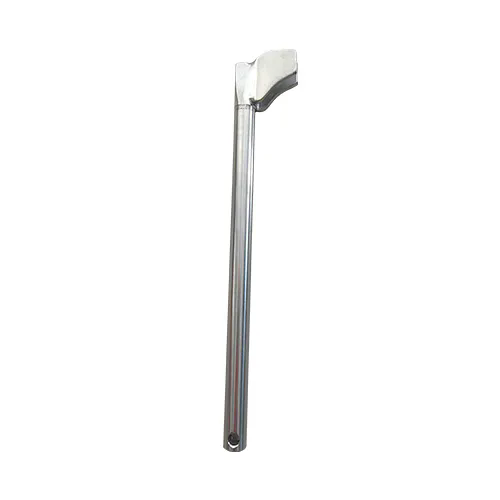The Transplanter Push Rod: Revolutionizing Planting Efficiency
2024-09-07
In the world of agriculture and gardening, the right tools can make all the difference in efficiency and productivity. Among these essential tools is the Transplanter Push Rod, a device designed to streamline the planting process and ensure optimal results. Whether you’re a professional farmer or an enthusiastic gardener, understanding the benefits and applications of the Transplanter Push Rod can enhance your planting techniques and save valuable time. In this blog, we’ll explore what a Transplanter Push Rod is, its key features, benefits, and how it can transform your planting experience.
What is a Transplanter Push Rod?
A Transplanter Push Rod is a specialized agricultural tool used to aid in the transplantation of seedlings and young plants. It is designed to facilitate the planting process by providing a mechanism for pushing seedlings into the soil with precision and ease. The push rod typically consists of a long, durable rod with a handle at one end and a mechanism at the other end that interacts with the soil and seedlings.
Key Features of the Transplanter Push Rod
1. Ergonomic Design
The Transplanter Push Rod is designed with ergonomics in mind. It often features a comfortable handle that allows for easy grip and maneuverability. This design reduces strain on the user’s hands and wrists, making it more comfortable to use for extended periods.
2. Adjustable Depth Control
Many Transplanter Push Rods come with adjustable depth control, allowing users to set the desired planting depth for different types of seedlings and soil conditions. This feature ensures consistent planting depth, which is crucial for the healthy growth of plants.
3. Durable Construction
The push rod is typically made from high-quality materials such as steel or heavy-duty plastic. This construction ensures that the tool is strong and durable enough to withstand the rigors of planting and working with various soil types.
4. Easy-to-Use Mechanism
The rod’s mechanism is designed to simplify the planting process. It usually includes a pushing mechanism that gently inserts the seedlings into the soil without damaging them. Some models may also include a release function that allows for easy removal of the seedling once it’s in place.
5. Versatile Application
The Transplanter Push Rod is versatile and can be used for various planting tasks. It is suitable for transplanting a wide range of seedlings, including vegetables, flowers, and ornamental plants. This versatility makes it a valuable tool for both small-scale gardeners and large-scale farmers.
Benefits of Using a Transplanter Push Rod
1. Increased Efficiency
The primary benefit of using a Transplanter Push Rod is its ability to increase planting efficiency. By providing a consistent and controlled method for inserting seedlings into the soil, the push rod speeds up the planting process and reduces manual labor.
2. Improved Plant Health
Consistent planting depth and proper seedling placement contribute to better plant health. The Transplanter Push Rod ensures that seedlings are planted at the optimal depth, which supports healthy root development and reduces transplant shock.
3. Reduced Physical Strain
Using a Transplanter Push Rod reduces the physical strain associated with manual planting. The ergonomic design and easy-to-use mechanism minimize the need for bending, kneeling, and excessive hand labor, making the planting process more comfortable.
4. Precision Planting
The push rod allows for precise planting, ensuring that seedlings are spaced evenly and planted at the correct depth. This precision leads to more uniform plant growth and improved crop yields.
5. Enhanced Soil Interaction
The tool’s design facilitates better interaction with the soil. It creates a well-defined planting hole without disturbing the surrounding soil excessively. This careful interaction supports optimal root growth and minimizes soil disruption.
6. Versatility in Different Soil Types
The Transplanter Push Rod is adaptable to various soil types, including sandy, loamy, and clay soils. Its durable construction and adjustable depth control allow it to perform effectively across different soil conditions.
How to Use a Transplanter Push Rod
1. Preparation
Before using the Transplanter Push Rod, prepare your planting area by ensuring the soil is adequately tilled and free of large rocks or debris. Mark the planting rows and spaces where you intend to place the seedlings.
2. Adjust Depth Control
Set the depth control on the push rod according to the type of seedlings you are planting. Different plants may require different planting depths, so adjust the rod accordingly.
3. Position Seedlings
Place the seedlings in the designated spots along the planting row. Ensure that each seedling is aligned with the planting hole created by the push rod.
4. Use the Push Rod
Position the push rod over the marked planting spot and gently push down to create the planting hole. Insert the seedling into the hole, ensuring it is at the correct depth. Release the seedling from the rod if it includes a release mechanism.
5. Secure the Seedlings
After planting, gently press the soil around the seedlings to secure them in place. Water the area as needed to help the seedlings establish their roots.
6. Maintenance
Clean the Transplanter Push Rod after each use to remove soil and debris. Store it in a dry, cool place to maintain its durability and effectiveness.
Conclusion
The Transplanter Push Rod is a valuable tool that enhances planting efficiency, precision, and comfort. Its ergonomic design, durable construction, and versatile applications make it an essential addition to any gardener’s or farmer’s toolkit. By streamlining the planting process and improving plant health, the push rod allows users to achieve better results with less effort. Whether you’re managing a large-scale farm or tending to a home garden, the Transplanter Push Rod is a game-changer that brings both practicality and ease to your planting routine. Embrace this innovative tool and experience the difference it can make in your gardening and farming endeavors.



